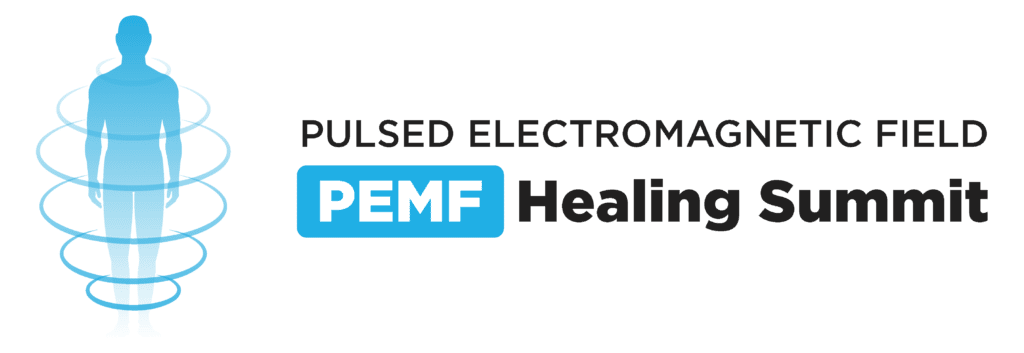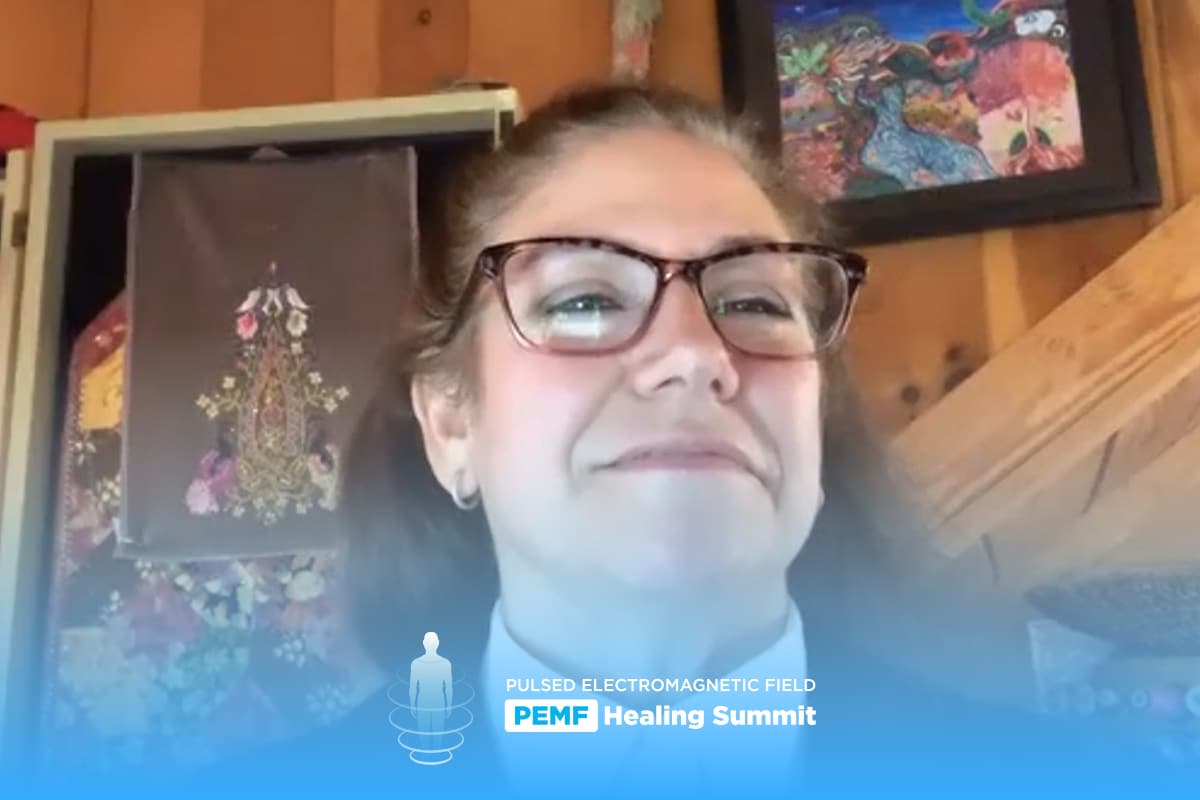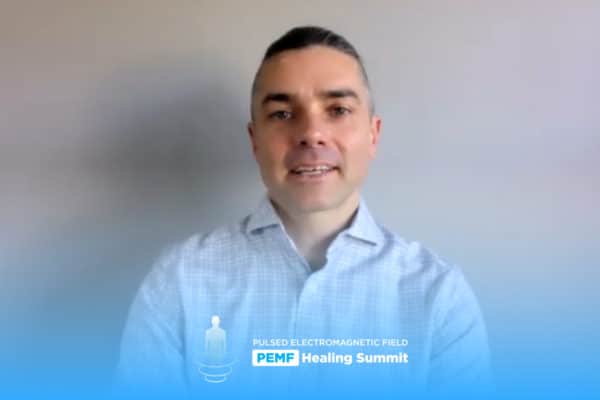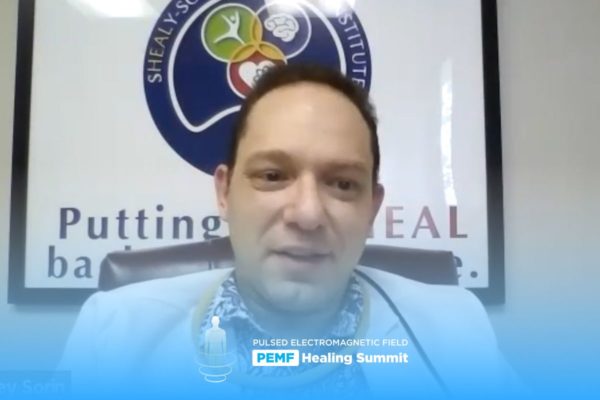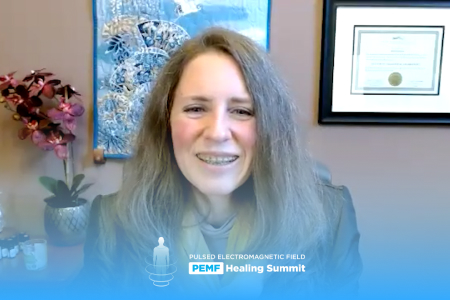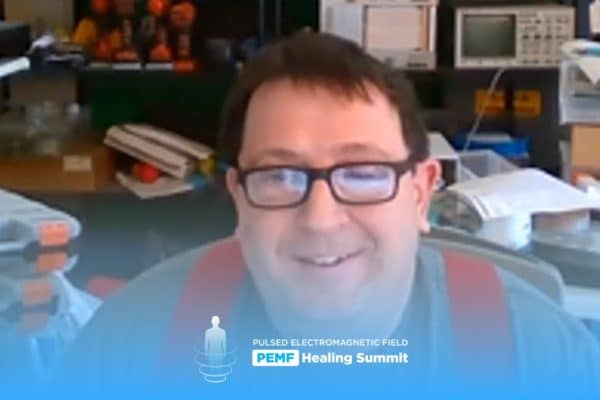Join the discussion below
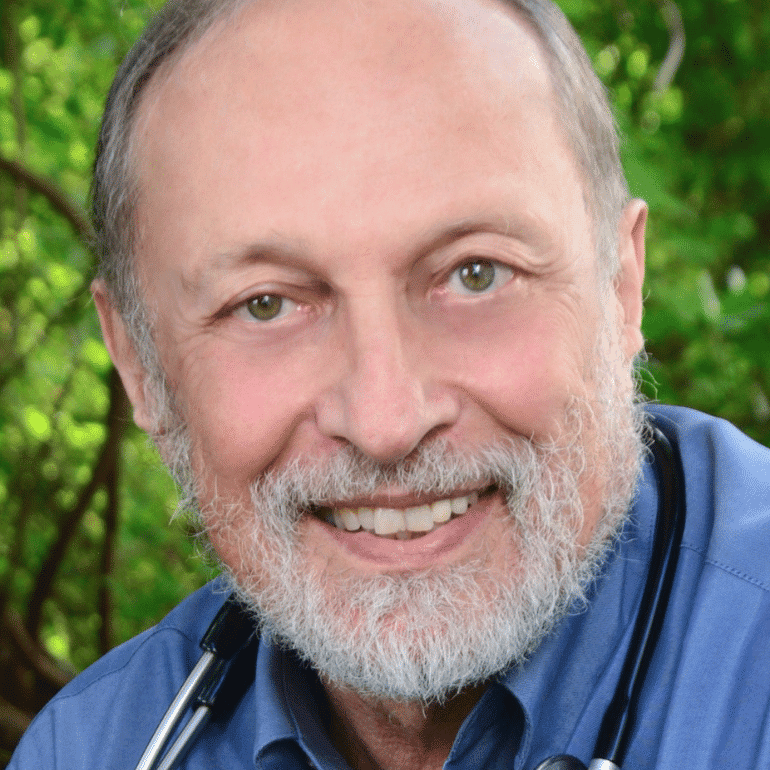
William Pawluk, MD, MSc, author of “Supercharge Your Health with PEMF therapy”, was recently a holistic doctor near Baltimore, MD. Previous academic positions at Johns Hopkins and University of Maryland. Training: acupuncture, homeopathy, hypnosis, energy medicine, nutrition and bodywork. Considered the foremost authority on the practical use of Pulsed Electromagnetic... Read More
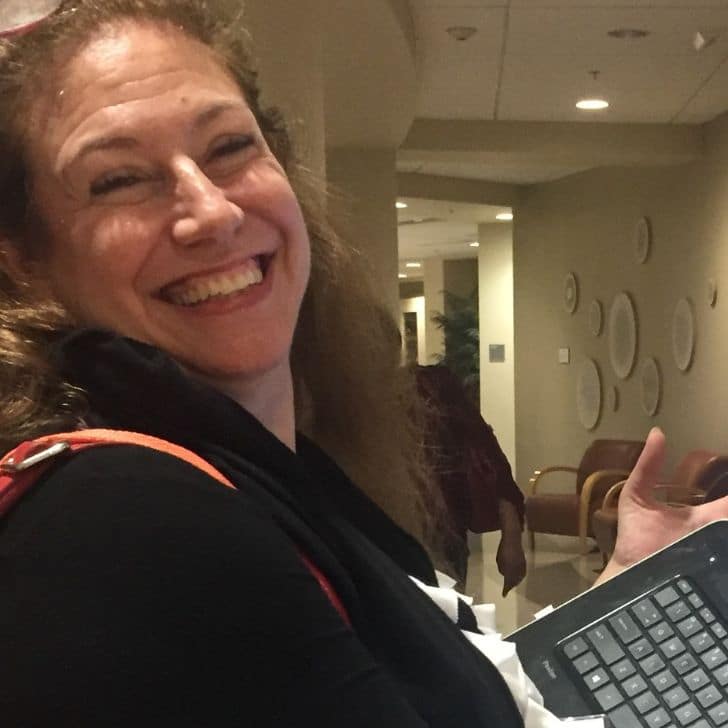
Stacey Ravid Ph.D. RN, MSN, CNS
Stacey Ravid Ph.D. RN, MSN, CNS has had an extraordinary nursing career spanning over twenty-four years. Her research focus is comprehensive solutions for the opioid epidemic: Holistic modalities for pain relief. Completing her doctorate in 2019, Dr. Ravid’s dissertation is a Descriptive Exploratory Study of Individual’s Use of PEMF, the... Read More
- The doctor conducted a descriptive, exploratory study and interviewed individuals because I wanted to hear their stories and their experiences using the Micro-Pulse PEMF device. Finding pain relief just revolutionized their life at that point. When they found pain relief, they were so excited and so happy and so relieved. One person, after he had one week pain-free, he stopped all alcohol and narcotics. Many stopped medications and narcotics. Pain was of many types: back, musculoskeletal, hip and coccyx pain; Alzheimer’s, carpal tunnel, pre-surgery/post-surgery recovery, sleep issues, sciatica, plantar fasciitis, arthritis, foot and ankle pain, multiple sclerosis, and complex regional pain syndrome. Alzheimer’s couldn’t read anymore and having emotional outbursts. After one week able to read again and calmed down. The number one thing she learned is that pain can be healed with an alternative modality like micro-pulse.
William Pawluk, M.D., MSc
Hi, this is Dr. Pawluk. This segment of the summit is about a very special issue that I think is very helpful to people to have information about. And that is, help magnetic field therapy actually works for individuals. And I have with me the celebrated Dr. Ravid. Now, Dr. Stacey Ravid wrote a PhD thesis. And when I read the thesis, I said I have to have her on this program. The thesis is a dissertation on the descriptive exploratory study of individuals who have used MicroPulse, a PEMF system, a portable battery-operated, PEMF system. Just so that you have a visual, this is what it looks like. Portable battery-operated, and it uses two little coils. This is what the people that Dr. Ravid is gonna talk about, who are using this particular device. So what I wanna do then is to have Dr. Ravid tell us about herself, her journey, and how she came to do this particular study.
Stacey Ravid Ph.D. RN, MSN, CNS
Hello, I’m Dr. Stacey Ravid and I researched many modalities over a period of years, and during my doctoral studies, I researched many different PMEF devices. My goal was to find holistic modalities for pain relief and after much research, I settled upon the MicroPulse. So I conducted… Let me tell you reason why I chose this as my dissertation study. I’ve been a nurse for over 24 years, an emergency department nurse for 17 years. I worked critical care ICU, hospice, in the last couple years of my career. And what I saw was a lot of patients were in chronic pain. And after all the pharmaceuticals and interventions, they still were not finding pain relief. And I saw that quite frequently in hospice. So that was part of my motivation for choosing holistic modalities for pain relief. Also, I’m quite concerned about the opioid epidemic, and my research goal is solutions for the opioid epidemic, thus, holistic modalities for pain relief. So, I conducted a descriptive exploratory study and interviewed individuals because I wanted to hear their stories and their experiences. If you’ll pardon me, I’m gonna read a couple of things off of my notes here. The main question that I was looking for was for individuals to tell me about their experience using the MicroPulse. And from that, I conducted nine survey questions and asked participants those survey questions.
William Pawluk, M.D., MSc
And a lot of it was open-ended as well. Right?
Stacey Ravid Ph.D. RN, MSN, CNS
Yes
William Pawluk, M.D., MSc
So it wasn’t just those questions, but there’s a big open-ended component to this. And I think this is what our viewers are gonna really be very interested in is the stories that you heard. So go ahead.
Stacey Ravid Ph.D. RN, MSN, CNS
Okay. So speaking of open-ended, the last question that I ask them is… The last two questions. How has living with pain affected your life, work, and relationships? And is there anything else about your experience with the MicroPulse that you would like to reveal? Those two questions were amazing and I could have just done the whole study on those two questions. Many patients revealed how pain had deeply affected their lives, work, relationships, every aspect of their lives and how finding pain relief just revolutionized their life at that point. So, I wanna just share with you, I interviewed participants over the phone and in person and listened to their interviews. Some interviews lasted from 20 minutes to an hour and a half. It took months to interview the participants. And then I would listen to the recordings. I tape recorded them and then I would transcribe them. Then I took the transcribed interviews and they were inserted into MAXQDA, which is a qualitative software program. And in analyzing their descriptions and their answers in MAXQDA, there were five themes that emerged. One of them was feeling hopeless. And that was a common theme for many of these participants. Some of them had been dealing with pain all their lives. There was one gentleman who had fallen out of a tree when he was five years old and he had been in chronic musculoskeletal pain for 40 years. The next theme was engaging in self-care. These participants were searching for answers. They were trying different modalities. They were going outside of the paradigm of the allopathic medical system. They were tired of pharmaceuticals. That’s how many of them found the MicroPulse. And then the three other themes were, finding pain relief, sharing the experience of pain relief, and modifying their use of pharmaceuticals. Many of these participants decreased or discontinued all pharmaceuticals once they had pain relief.
William Pawluk, M.D., MSc
That’s wonderful.
Stacey Ravid Ph.D. RN, MSN, CNS
Yes. Yes.
William Pawluk, M.D., MSc
That’s wonderful. So let’s go with each of those themes. And what did you find in your study as you had your interviews?
Stacey Ravid Ph.D. RN, MSN, CNS
Okay. Starting with feeling hopeless, this was pretty amazing to hear so many people’s stories. So there were 28 participants that were included in this final dissertation study. And I would pretty much say that 27 out of the 28 were feeling hopeless, and just a loss of their ability to ever be pain-free or be pain-free over any consistent period of time. When they found pain relief, these participants, they were so excited and so happy and so relieved, that one of the most amazing themes that I found in the study was that they wanted to share this with people. So these participants started telling people about the MicroPulse. They blogged about it. One person made an app for their phone about the MicroPulse, and when he was out and met people who were in pain, he would share it with them. Many participants bought the MicroPulse for people. Doctors. They shared it with their doctors, their chiropractors. And then last, modifying the use of pharmaceuticals. I’m just gonna focus that on one patient’s story. There was a gentleman who had been in chronic musculoskeletal pain for many years, and he had become addicted to narcotics and alcohol. He said that he felt he would never be pain-free again. Once he started using the MicroPulse and he was having relief, it took him a little bit longer but he said that after he had one week of pain-free, he discontinued all alcohol and narcotics and had never touched them again.
William Pawluk, M.D., MSc
Wow.
Stacey Ravid Ph.D. RN, MSN, CNS
So that was a really amazing story. And I heard that with a lot other participants that they stop their medications and stop narcotics. So, some of the things that I wanna share with you that they use the MicroPulse for because it was quite varied. One thing really important to tell you all is that when a participant used the MicroPulse for one type of pain or condition and they had success, then they would try it for something else. So, I have a long list of things that people used it for because oftentimes somebody would use it for four different things. So some of the things, ailments that people used it for were: headaches, dental pain, AFib, all types of back pain and musculoskeletal pain, Alzheimer’s, carpal tunnel, all types of hip and coccyx pain, pre-surgery, post-surgery recovery, sleep disturbances, degenerative disease, sciatica, plantar fasciitis, arthritis, foot and ankle pain, shoulder, multiple sclerosis, and complex regional pain syndrome.
William Pawluk, M.D., MSc
That’s not an atypical finding with PEMFs is that people naturally will say, “How can one thing do so many things” right? Do you wanna say why?
Stacey Ravid Ph.D. RN, MSN, CNS
My personal opinion is that it somehow decreases the inflammation and it works on such a deep level, deep into nerve or bone or tissue, that it helps to heal the pain.
William Pawluk, M.D., MSc
So it’s not just about pain, but a person with AFib doesn’t feel pain.
Stacey Ravid Ph.D. RN, MSN, CNS
Correct. But it’s the inflammation that it’s working on.
William Pawluk, M.D., MSc
Well, and we’re gonna have a whole segment, another segment about PEMFs and what PEMFs are, what they do and how they work and so on. So rather than getting into the physiology and exactly how it works, but pain relief and the reason for this summit of course, is pain relief. But pain relief is pain happening at people with all kinds of other problems, right? As many of the people as you’re describing had multiple problems, pain wasn’t the only problem that they had.
Stacey Ravid Ph.D. RN, MSN, CNS
Correct.
William Pawluk, M.D., MSc
And they got benefits for many things as well, right?
Stacey Ravid Ph.D. RN, MSN, CNS
Yes. One of the most interesting stories is one gentleman used the MicroPulse on his mom who was having Alzheimer’s. And she couldn’t read anymore, and she was having emotional outbursts, and they used the MicroPulse and after one week she was able to read again.
William Pawluk, M.D., MSc
Wow
Stacey Ravid Ph.D. RN, MSN, CNS
And she calmed down. Yeah.
William Pawluk, M.D., MSc
So the MicroPulse not only relieves pain and not only decreases inflammation, it actually decreases swelling in the tissues. It also just enhances the function of tissues. ‘Cause if you have swelling in tissues, you don’t have adequate circulation and you have inflammation that other functions don’t work well in those tissues as well. Right? So, if you do some of these very basic actions, then a lot of things downstream will get better from the problem.
Stacey Ravid Ph.D. RN, MSN, CNS
Yes. Yes. As a researcher, one of the things that I was looking for was, is the MicroPulse healing their pain permanently or is it just temporary? And one of the things that I found is that for majority of the participants, it did heal the pain. However, patients who have had longstanding difficulty, like the gentleman who had musculoskeletal pain for 40 years, it took him a while, many months of using the MicroPulse before he was actually pain-free. With acute situations, it seems to work right away and cure the pain.
William Pawluk, M.D., MSc
Much faster.
Stacey Ravid Ph.D. RN, MSN, CNS
It’s also dependent on the individual and the type of pain.
William Pawluk, M.D., MSc
Yeah. This is also something that we deal with at drpawluk.com, as we talk about the different tissues that are involved, the depth of the problem, how long it’s been there, and whether you’re getting functional improvement or whether you’re looking to heal. Obviously, healing is more valuable than immediate symptom reduction because if you’re healing something, then the problem was more likely to go away permanently.
Stacey Ravid Ph.D. RN, MSN, CNS
Correct.
William Pawluk, M.D., MSc
Right?
Stacey Ravid Ph.D. RN, MSN, CNS
Correct. Yes.
William Pawluk, M.D., MSc
How would this change the work you do as a nurse? What you know now from this study?
Stacey Ravid Ph.D. RN, MSN, CNS
Well, one of the questions I’ve been asked by people is, what did I learn from this study that I didn’t know before? And the number one thing that I’ve learned is that pain can be healed with an alternative modality like MicroPulse, without using any pharmaceuticals. I was skeptical when I started the study, wondering if patients would really have long-lasting pain relief, and in fact, they have. So how it changes my work as a nurse is that some patients in chronic pain if they are taking pharmaceuticals, maybe they could use Pulsed Electro-Magnetic Field devices to help and augment their pain-healing experience.
William Pawluk, M.D., MSc
Now, we’re looking for you to share this with your colleagues, right?
Stacey Ravid Ph.D. RN, MSN, CNS
Yes, I am right now .
William Pawluk, M.D., MSc
Not just your academic colleagues, but also you’re practical nursing profession or nursing colleagues or friends.
Stacey Ravid Ph.D. RN, MSN, CNS
Yes.
William Pawluk, M.D., MSc
Other nurses that you run in with, because you’re a teacher now, right?
Stacey Ravid Ph.D. RN, MSN, CNS
Yes. I’m an instructor at a university, correct. Yes.
William Pawluk, M.D., MSc
So I I’m sure that you’ll let them know that PEMFs are something that could be very useful.
Stacey Ravid Ph.D. RN, MSN, CNS
Yes. But they also have to consult with their doctor if they’re on medications or they’re having surgery, and… But it is something that they can use safely. It’s not contraindicated, it’s not harmful. There’s no way they could hurt themselves. So it is something that they could use in conjunction with other modalities, including pharmaceuticals, if they chose.
William Pawluk, M.D., MSc
Now in your interviews with people, did you hear about problems with the MicroPulse?
Stacey Ravid Ph.D. RN, MSN, CNS
No. There were just some concerns about how to keep it on. People wanted to sleep with it. They wanted to wear it to work. So different people had to figure out how to do that best for themselves. One gentleman wore on his neck at work all day. And so he had it and it was showing, and he didn’t want people asking him about it. So he put a scarf on, but not too many problems. When you asked me that question, I flashed upon some of the difficulty that the participants had with their primary caregivers and doctors. They were telling their doctors or their chiropractors or different people about the MicroPulse and many of them found that the doctors weren’t that interested in the MicroPulse. And one participant went to their doctor. He had been in pain for many years taking pharmaceuticals, was about to have surgery, and he said to his doctor, “I’m pain free, and I’m gonna hold off on the surgery.” He said he was surprised that the doctor didn’t wanna see the device, didn’t wanna hear about it, really had no interest in what helped him.
William Pawluk, M.D., MSc
Well, this is another reason for this program series. Is that we’re providing people with tools that they could use themselves, and they don’t have to be accepted by the medical profession, but more and more professionals are starting to recognize the value of these, particularly professionals that are not part of mainstream medicine, more and more within mainstream medicine recognizing it as well. But they’re pretty stuck at a particular paradigm and say, “Don’t fool me with… I don’t wanna change.” Right? “I like what I do. It works for me.” But obviously we’re discovering as you found that there are lots of people out there for whom it is not. The traditional system is not working, clearly.
Stacey Ravid Ph.D. RN, MSN, CNS
Can I read you just a brief paragraph of one patient’s story?
William Pawluk, M.D., MSc
In fact, we’d like to hear some more stories, if you don’t mind.
Stacey Ravid Ph.D. RN, MSN, CNS
Okay. I’m gonna tell you about this one patient. He had used the MicroPulse for shoulder pain and had relief. Had been in 10 outta 10 pain for a very long time. Tried many different things, nothing worked, heard about the MicroPulse from a friend and used it. So, one of his unique uses of the MicroPulse was that he used it for jaw pain and it was so successful that before he went to the dentist, he would use the MicroPulse before he went to the dentist. And then after the dentist, he claims that he did not need Novocaine because the MicroPulse was so effective. After successfully using it for that type of pain, he decided to try it on his eye because he was losing his eyesight and he was needing stronger and stronger glasses each time he went back to his ophthalmologist, and used it on his eye, and his eye reverted to a 20/20 vision, whereas the right eye remained the same.
William Pawluk, M.D., MSc
The one that wasn’t being treated?
Stacey Ravid Ph.D. RN, MSN, CNS
Yes, he did it. Yes. And then he ended up using it on both eyes, had 20/20 vision, and then his wife did the same thing. And when they went to their eye doctor who was aware of this whole process, he was happy for them. He was amazed. But once again, he really wasn’t interested in seeing the device or hearing about how it worked for them, but he claims he got his 20/20 vision back.
William Pawluk, M.D., MSc
Well, and hopefully he’ll have a sustained result, right?
Stacey Ravid Ph.D. RN, MSN, CNS
Yes.
William Pawluk, M.D., MSc
And if it doesn’t, if it starts and revert back again, all he has to do is to do it again.
Stacey Ravid Ph.D. RN, MSN, CNS
MicroPulse. Yes. There’s a story. It’s one of my favorite stories of the participants that I interviewed, of a young woman who was in a motor vehicle accident. She was blindsided on driver’s side and she had multiple surgeries, multiple pain. It went on for years. Doctors couldn’t help her. She’s a 36 year old female. Before the accident, she had been a golfer. She was an investment advisor. She had a very active life. Once she had the accident and she was in pain, she was pretty much bedridden most of the time. So long story short, she said that she spent close to $30,000 on holistic modalities. At the very end, she was giving up hope, and she found out about the MicroPulse. She used the MicroPulse. She started having relief. And long story short, when I talked to her, she was finally getting her life back. And that day she was working out, she was going to dinner, and she was hoping to start playing golf again. So, this was an interview that lasted about an hour and a half, and there are many details to it, but she described her pain experience and what she went through in the allopathic medical system, and how she felt that she wasn’t being heard, and she wasn’t being helped. And through it all, she felt like she was on her own. And she was really happy when she found the MicroPulse because it gave her what she called autonomy. And that was the one thing she was missing in her whole experience.
William Pawluk, M.D., MSc
How long had you been using it for?
Stacey Ravid Ph.D. RN, MSN, CNS
She had been using it for a year.
William Pawluk, M.D., MSc
For about a year at that point. So it took her quite a while to see improvement. What did you-
Stacey Ravid Ph.D. RN, MSN, CNS
No, she had improvement after about the first two months.
William Pawluk, M.D., MSc
Two months?
Stacey Ravid Ph.D. RN, MSN, CNS
Yeah. But she still continued to use it.
William Pawluk, M.D., MSc
So in the first two months, she improved by what percent? How much do you know that? By how much?
Stacey Ravid Ph.D. RN, MSN, CNS
That I don’t know off the top of my head. I do know that after using it for two months, she was able to start working out again.
William Pawluk, M.D., MSc
Ah.
Stacey Ravid Ph.D. RN, MSN, CNS
After not being able to exercise for many years.
William Pawluk, M.D., MSc
Years?
Stacey Ravid Ph.D. RN, MSN, CNS
Yeah.
William Pawluk, M.D., MSc
And the nature of her pain was what again?
Stacey Ravid Ph.D. RN, MSN, CNS
Musculoskeletal.
William Pawluk, M.D., MSc
No specific diagnosis that she was able to give?
Stacey Ravid Ph.D. RN, MSN, CNS
Just she had neck… She had vertebrae. I don’t remember which ones, but her vertebrae had been out. She also had rib pain, lower-back pain, and headaches, that was another thing, was constant headaches.
William Pawluk, M.D., MSc
And how old was she?
Stacey Ravid Ph.D. RN, MSN, CNS
36.
William Pawluk, M.D., MSc
36. Relatively young lady. Almost sounds like a fibromyalgia pattern, mixed, probably other things as well. But she went back and started playing golf again.
Stacey Ravid Ph.D. RN, MSN, CNS
Yes.
William Pawluk, M.D., MSc
How did you find in your surveys or your discussions with people about the impact of the MicroPulse on people’s sleep?
Stacey Ravid Ph.D. RN, MSN, CNS
Yes. People said that they were able to sleep better. I, myself have been using the MicroPulse and I find that I’m sleeping for longer duration as well. Using it for pain, maybe it’s because it’s decreasing the pain, and so people are able to sleep. There were a couple participants that I interviewed who actually… And I wanna show you this. Who used the MicroPulse to help them sleep. Their pain was gone, but they were using it for sleep. So this is… I’m gonna turn this. This is a grid that I made of the different participants and the different themes, and their statements. Can you see that doctor?
William Pawluk, M.D., MSc
Yes, I can. Thank you.
Stacey Ravid Ph.D. RN, MSN, CNS
Okay. So there’s 28 of these and in several of them, people talk about how it helped them with sleep. Then also what I did with this study was I wrote down just noteworthy quotes that people said to me that we’re very impactful, and then I color coded them. And-
William Pawluk, M.D., MSc
Dr. Ravid, could you please put your screen down so we can see it better, or you’re moving away from there? Okay. Okay. That’s… There you go.
Stacey Ravid Ph.D. RN, MSN, CNS
Yeah. So in the noteworthy comments, there were several words where people talked about how they were using the MicroPulse to help them with sleep.
William Pawluk, M.D., MSc
So we should probably say that the MicroPulse is battery-operated. It basically goes this way. Because it’s battery-operated, it will work continuously until the battery dies, and that has to be recharged or replaced. And then you have these little coils. And this is what we’re talking about, being able to put it on different parts of the body to hold it in place. So they don’t stick to the body. You have to place them on the shoulders or on the head, the back of the head, on the wrist, a carpal tunnel. I’ve used it successfully to treat my own carpal tunnel syndrome. It’s been amazing for that, but it can be used continuously. So there’s no harm in using it for 24 hours at a time.
Stacey Ravid Ph.D. RN, MSN, CNS
That’s correct.
William Pawluk, M.D., MSc
Now, once you get benefit from it, I’m sure that you’ve heard this. Once you start to get benefit, you decrease the treatment time. You don’t need to use it as often. And your results will dictate how long you have to use it for.
Stacey Ravid Ph.D. RN, MSN, CNS
Correct. Correct. I was telling you at the beginning of this, I recently had dental pain, and it was so bad that I couldn’t eat. And I would apply the MicroPulse to my tooth. It would decrease the pain. I was able to eat a meal. And then I would use the MicroPulse after. I also had an ankle injury. It was such a bad injury that I thought I was gonna have to have surgery. I used the MicroPulse, and within two weeks it was better, and my ankle has healed. I wanna tell you something really important about the MicroPulse that I’ve learned, personal experience and the participants. Once you use the MicroPulse for something and you have relief, you keep it with you. And many of the participants talked about that. I have mine. I carry it with me now in my purse all the time. It’s like those fashion magazines of what’s in your purse. Well, what’s in mind is I have my MicroPulse. I have the battery. I have all the little paraphernalia that I need for the MicroPulse, and many of the participants do the same thing. We all carry it now with us wherever we go.
William Pawluk, M.D., MSc
It’s very light. It’s very small. It’s certainly very easy to do. Personally, I think that every family should have one. Every family.
Stacey Ravid Ph.D. RN, MSN, CNS
Yes .
William Pawluk, M.D., MSc
‘Cause we all have nicks and scratches and freckles, and so on.
Stacey Ravid Ph.D. RN, MSN, CNS
And pains.
William Pawluk, M.D., MSc
And the older we get, of course the more of that experience we have. But they’re very safe in pets. Did you have any pet experiences? Did anybody tell you about pets?
Stacey Ravid Ph.D. RN, MSN, CNS
Oh. Not me, but the participants, there are some amazing stories about how they used the MicroPulse for their pets. One gentleman, they were about to put his pet down. Their dog was about 14 years old. It couldn’t go up and down the stairs anymore, and it was sick. And they used the MicroPulse on it, musculoskeletally on the four legs. And after one week, the dog was able to go up and down the steps. And he said that the dog lived for about another year.
William Pawluk, M.D., MSc
Excellent.
Stacey Ravid Ph.D. RN, MSN, CNS
Horses. People use the MicroPulse on horses, dogs, cats. Yes.
William Pawluk, M.D., MSc
So, one of the things I tell people is that when you buy one of these devices, you don’t own it.
Stacey Ravid Ph.D. RN, MSN, CNS
Yeah, that’s right .
William Pawluk, M.D., MSc
The house owns it,
Stacey Ravid Ph.D. RN, MSN, CNS
Right. I had a daughter-
William Pawluk, M.D., MSc
Including dog, the cat, and the plants.
Stacey Ravid Ph.D. RN, MSN, CNS
Family.
William Pawluk, M.D., MSc
Right?
Stacey Ravid Ph.D. RN, MSN, CNS
Right. My daughter’s used it. My son has used it. My husband’s used it. A lot of my friends have used it. I don’t loan mine out anymore. I tell them they have to get their own. Yeah.
William Pawluk, M.D., MSc
Yes. Well, this little machine has puts out about 200 gauss. So gauss is a measure of magnetic field intensity. There are devices out there that are a comparable price, but they’re only about nine gauss. So this is a pretty strong little fella. If you wanna call it a fella, or a girl.
Stacey Ravid Ph.D. RN, MSN, CNS
Okay .
William Pawluk, M.D., MSc
Whatever.
Stacey Ravid Ph.D. RN, MSN, CNS
Yeah.
William Pawluk, M.D., MSc
It’s called a MicroPulse like Mighty Mouse.
Stacey Ravid Ph.D. RN, MSN, CNS
Yes. It is like Mighty Mouse.
William Pawluk, M.D., MSc
Might mouse.
Stacey Ravid Ph.D. RN, MSN, CNS
Yeah. So going forward, one of the things that I would like to do is educate people and help people to see that there are different options for pain relief besides the conventional Tylenol, Ibuprofen, narcotics, fentanyl, all the different medications. And that PEMF is one potential modality that they could use to relieve pain. A lot of people don’t know about PEMF. As I’ve done my dissertation and I talk about it, many people have asked me, what’s PEMF? I’ve never heard of that before. That’s been pretty surprising.
William Pawluk, M.D., MSc
That’s not surprising to me whatsoever. It’s much more common in Europe, more accepted in Europe. It’s been around in Europe for probably 60 years already. We’re kind of late to the PEMF world and the possibilities that we have. And the MicroPulse is currently one of the best ways of doing this because it’s so portable. You don’t tie it down. You have to plug it in the wall and use it in the wall. You don’t have to have it prescribed by a doctor. Right?
Stacey Ravid Ph.D. RN, MSN, CNS
Right. And it’s pretty safe.
William Pawluk, M.D., MSc
You don’t really need medical advice on how to use it, typically.
Stacey Ravid Ph.D. RN, MSN, CNS
That’s correct. Something else that’s interesting is that people know what TENS is. And many people have had TENS when they go to the chiropractor. So the Pulse Electro-Magnetic Field is similar to TENS but it’s quite different. Can you tell me exactly what the difference is between PEMF and TENS? Many people have asked me this and I’m curious what your response to this question is.
William Pawluk, M.D., MSc
Well, one of the ways to think about TENS is that, T-E-N-S is a bit like stopping on your toe when you have a headache, right? All you’re doing is distracting the headache. You go to a new pain that’s taken the place of the old pain, which doesn’t last necessarily that long. So there’s something called the gate control theory. If you present a stimulus to the body here, that’s different than say the headache stimulus. Then the brain, the gateways in the brain, and then spinal cord get loaded with this new information. And they’re distracted from recognizing or acknowledging the old pain. That’s largely what TENS does, it’s a distraction. So in a sense, this is the TENS unit. This is not a TENS unit, but let’s say this is the TENS unit and this is the pads or the coils that you get with TENS. TENS requires a pad which usually requires gels to put on the body, and it has to be up against the skin. Magnetic fields are emanating from the coil as if the coils were not even there. The body doesn’t have to get changed or you don’t have to go through clothing. It can go through shoes. It can go through casts. It goes through bones equally. It doesn’t matter. To a magnetic field, the body is like air. That’s the basic difference. So TENS is a superficial acting. Electrical currents when you apply them to the skin or don’t go deep, they basically stay in the surface of the skin. And they basically get loaded into the nervous system and the body says, ooh, right? Magnetic field therapy most of the time, do you feel this?
Stacey Ravid Ph.D. RN, MSN, CNS
No.
William Pawluk, M.D., MSc
You don’t feel anything. What you hear is a clicking in the coil, and that’s it. That’s all you… Most of the time you hear nothing. But the magnetic field goes through the body completely. Right? Goes all the way through the tissues. So that’s a major difference between TENS and PEMF. PEMF is healing, TENS is distracting.
Stacey Ravid Ph.D. RN, MSN, CNS
Good answer. Okay. May I use that?
William Pawluk, M.D., MSc
It’s yours?
Stacey Ravid Ph.D. RN, MSN, CNS
Yeah. I just wanna show you to my… Dissertation was published.
William Pawluk, M.D., MSc
Wonderful.
Stacey Ravid Ph.D. RN, MSN, CNS
And so going forward, one of the things that I would like to do is talk to different doctors or surgeons, and maybe do a study with the MicroPulse on post-op patients to help them in their post-op pain and also to possibly decrease the amount of medications they’re having to take. That’s one of the things that I’m thinking about now.
William Pawluk, M.D., MSc
Well, I think probably we’ll have to do some work together about this. I could tell you my personal experience. I had an elective appendectomy. So on colonoscopy, a little lesion was found in the opening of my appendix and well, we had a discussion about that, decided we didn’t know what it was, so let’s remove it. That happened on a Friday. So if elective surgery, I wasn’t in pain or anything. Did the procedure on Friday midday. I used that basically the MicroPulse over… I had three stab wounds. This only has two coils. So I used one coil on two stab wounds. I left the other one as a control at sense. I didn’t treat it, all right? Worked for 24/7, I was back to work on Monday.
Stacey Ravid Ph.D. RN, MSN, CNS
Wow.
William Pawluk, M.D., MSc
No abdominal discomfort. I could cough. I could sneeze. I could move or bend. I could stand. I could sit down, with no discomfort.
Stacey Ravid Ph.D. RN, MSN, CNS
That’s a fascinating-
William Pawluk, M.D., MSc
And so the wound healing was accelerated but importantly the swelling was reduced, the edema was… Well the swelling, the inflammation was reduced and the pain was basically gone. And my muscles were not that irritated. ‘Cause when you cut into the muscles when you do an appendectomy, the muscles are gonna be sore. So how long does it take to recover from an appendectomy?
Stacey Ravid Ph.D. RN, MSN, CNS
Depends on the patient. Depends on their health going into the surgery. It can be anywhere from two weeks to several months.
William Pawluk, M.D., MSc
But not three days.
Stacey Ravid Ph.D. RN, MSN, CNS
Not three days. No.
William Pawluk, M.D., MSc
All right. So if you need time off work after your appendectomy, you’re gonna want six weeks.
Stacey Ravid Ph.D. RN, MSN, CNS
Yes. Wow.
William Pawluk, M.D., MSc
Right? And you may not need to. For those of you who don’t have that kind of health insurance or that kind of coverage from your employer and you wanna get back to work, yeah, this is a miraculous little device.
Stacey Ravid Ph.D. RN, MSN, CNS
Yeah. I think it could be very useful for post-op patients.
William Pawluk, M.D., MSc
Well, pre-op and post-op actually. So why would you wanna do a pre-op?
Stacey Ravid Ph.D. RN, MSN, CNS
To decrease the inflammation?
William Pawluk, M.D., MSc
Yes. And also, but more importantly, actually to optimize the cells, the function of the tissues. If you optimize the cells, optimize the function of the tissues before this procedure. So if I put the magnetic field here before the procedure, then I cut through that area during the procedure and I put magnetic fields right afterwards, the wound is decreased when you cut, because you’re stimulating all kinds of heating factors that go into that tissue before you actually traumatize it through the surgical process. So then you recover much faster. And that’s called heat stress protein or heat shock protein, which is a trauma to the tissues. So you pretreat, then you do your procedure, then you, immediately right after the procedure, you start back to treating again and you’ll recover much faster.
Stacey Ravid Ph.D. RN, MSN, CNS
Yeah. I think there’s potential here for the MicroPulse to help surgical patients for sure.
William Pawluk, M.D., MSc
And they actually did a study about that at Columbia University, for cardiac surgery patients to pretreat them to increase heat stress protein or heat shock protein. So that there’s less myocardial irritation, inflammation, damage, and so on from that procedure. So it’s being studied at major universities, for skin, post, pre-op treatment.
Stacey Ravid Ph.D. RN, MSN, CNS
Good. Good.
William Pawluk, M.D., MSc
Do you have any other stories to share with us?
Stacey Ravid Ph.D. RN, MSN, CNS
Oh, yes.
William Pawluk, M.D., MSc
I love stories.
Stacey Ravid Ph.D. RN, MSN, CNS
Yes. I… You know what, I’d like to just read you a couple of their statements and then I’ll end with one story. It is one of those things I think every family should have for their family’s health because it is so powerful. The PEMF device works faster and I think it has a healing aspect to it that the TENS doesn’t have. This was a patient that suffered from consistent musculoskeletal pain and they finally got relief with the MicroPulse. I think every family should have one, at least one. So this is something else that I kept hearing from people is that they wanted everyone in their family to use it and to try on it. Between the MicroPulse and altering my diet, I was able to heal my GERD. This was a patient who suffered from GERD since he was a child.
William Pawluk, M.D., MSc
Oh, GERD is gastroesophageal reflux disease.
Stacey Ravid Ph.D. RN, MSN, CNS
Gastroesophageal reflux disease. Yes. And he had taken medications for many years. Of course we know there are side effects from those medications. As a nurse, what I tell people there are the medications and then there are side effects from those medications. And we always have to keep that in mind when we’re taking pharmaceuticals. And this participant was so tired of taking pills, he said he was tired of swallowing, tired of taking medicine, and used the MicroPulse and it healed his GERDS.
William Pawluk, M.D., MSc
You know how long he used it for before his G-E-R-D got better?
Stacey Ravid Ph.D. RN, MSN, CNS
This one I believe was about a month and a half.
William Pawluk, M.D., MSc
Yeah.
Stacey Ravid Ph.D. RN, MSN, CNS
For this participant. So, that’s something else people need to keep in mind is depending on your condition, it could happen right away. The relief that you get from the Pulse Electro-Magnetic Field devices, or it can take longer. So you just have to be patient with it. Speaking of which, there was one participant who had tried the MicroPulse for neck pain and it didn’t work, and he was about to give up. And his brother who convinced him to use it, who had used it for elbow and shoulder pain relief. Said to his brother, “Just try it for one more week.” Within that week, he started having relief. And that participant went off all of his medications and used the MicroPulse for his neck pain.
William Pawluk, M.D., MSc
Wonderful.
Stacey Ravid Ph.D. RN, MSN, CNS
Yes. So I’d like to leave you with one story. And this is actually a nurse, and she had had chronic musculoskeletal pain, chronic foot pain from standing for 12 hour shifts. She had been a nurse for many years. She also had injured her neck from lifting a patient and she had upper back pain, chronic upper back pain. And she was traveling around the country as a travel nurse. So as nurses, we can go and travel somewhere and work there for eight weeks. And so that’s the type of nursing she was doing, and she was a critical care nurse. She said that she was in chronic pain depending on the level of pain, anywhere from a two to a 10 throughout the day, and certainly during her shifts. She started using the MicroPulse, and then when she was driving to the different locations for her job, she would use the MicroPulse while she was driving. She said by the time she got to the new gig, her pain would be gone. She started using it from head to toe for all of her pain, and after about six months, she said that she was pain-free for the first time. In quote, “She didn’t know how long.” So that’s her-
William Pawluk, M.D., MSc
And she used at different parts of the body for the different areas of pain?
Stacey Ravid Ph.D. RN, MSN, CNS
Yes. Yes. Neck, upper back. She had lower back pain. She had right hip pain, right knee pain, and then feet. She said her feet were in chronic pain all the time.
William Pawluk, M.D., MSc
Yeah. Very common. So it’s very safe to be using it in different parts the body and it’s very safe to use it around the brain. I use the MicroPulse type device for treating concussions.
Stacey Ravid Ph.D. RN, MSN, CNS
Oh.
William Pawluk, M.D., MSc
Basically the same thing. The MicroPulse has two programs. It has basically one program, but it recycles. So it’s got 10 Hertz for 10 minutes and 100 Hertz for 20 minutes, and then it recycles. So it’s constantly recycling those two frequent sets of frequencies. So you can use it for brain injuries as well, very easily. By the way, it’s also extraordinary safe with kids. Did you have any stories about kids using it?
Stacey Ravid Ph.D. RN, MSN, CNS
Yes. One gentleman used it for his child who was having outbursts. They’re not sure what was happening, but he was crying a lot, screaming a lot, couldn’t sleep. And they used it for him. They did use it on his head and they had some relief. And he was able to sleep, he calmed down.
William Pawluk, M.D., MSc
And for that, you may not heal as much as you do change behavior, you change the way the brain functions and it makes you relax. Almost everybody says when they use these things, particularly around the head, they feel very relaxed.
Stacey Ravid Ph.D. RN, MSN, CNS
Yeah. To leave you with one last story.
William Pawluk, M.D., MSc
Yes, please.
Stacey Ravid Ph.D. RN, MSN, CNS
There is a woman that I interviewed who used it for her musculoskeletal pain. She had relief and then she used it on her head for meditation. And she said that-
William Pawluk, M.D., MSc
Oh, meditation.
Stacey Ravid Ph.D. RN, MSN, CNS
She ever had deeper meditations than she ever had before. And she used it as a daily practice for meditation.
William Pawluk, M.D., MSc
There you go. So it has so many different uses, not just for pain, right?
Stacey Ravid Ph.D. RN, MSN, CNS
Yes.
William Pawluk, M.D., MSc
So one little tool for a person with pains that has a lot of other normal health issues, it has a whole range of benefits.
Stacey Ravid Ph.D. RN, MSN, CNS
Yes. Personally, I am going to follow my participant’s advice. The one who used it for his eyes to have the 20/20 vision. And I’m gonna do my own study on myself and try it on my eyes, and see if it works.
William Pawluk, M.D., MSc
So there are some different theories about vision and how we do need glasses. One of the theories in fact is that it’s because of the imbalance of the muscles of the eyes. The muscles that controls movement of the eyes, they can stress anywhere else, like clenching your fists or clenching your jaw. We can cause those muscles in our eyes to contract as well and be chronically contracted. So you can change the pull of the muscles around the eyes to change the shape of the eyeball.
Stacey Ravid Ph.D. RN, MSN, CNS
Wow.
William Pawluk, M.D., MSc
So if you cause a relaxation of those muscles, the eyeball can go back into its own shape, but it depends on how long the problem has been there and how severe the nearsightedness is. Particular nearsightedness. So it could take a while to have these changes happen, especially the bigger the prescription. ‘Cause again, the bigger the prescription, the more change there is in the shape of the eyeball. So give yourself some time.
Stacey Ravid Ph.D. RN, MSN, CNS
I will, and I’ll get back to you on that and let you know how it goes, okay?
William Pawluk, M.D., MSc
I look forward to it.
Stacey Ravid Ph.D. RN, MSN, CNS
Yes. I look forward to it too.
William Pawluk, M.D., MSc
Well, I do wanna say that MicroPulse is available in two places. It’s available on micro-pulse.com, micro-pulse.com. And it’s also available on drpawluk.com. So, I’ve been working with the developer of this device for years and I really like it, it works extraordinarily well.
Stacey Ravid Ph.D. RN, MSN, CNS
The developer, Dr. Robert Dennis, he invented the device and he’s continuously perfecting it.
William Pawluk, M.D., MSc
He is, and we are continuing to do work with him as well for other purposes. There’s another comparable device, battery-operated again. It’s gotta rechargeable battery. But it’s got six programs. So the MicroPulse has only one program, this one is six. It’s more expensive because it has six programs. But it does the same thing. So if you want an expanded reach of abilities to be able to use it for sleep or for meditation, or for making you alert, then the FlexPulse may be a better solution. But either one, most important thing is that you get something that you can use that will help you, as much as possible. Wonderful. Thank you so much-
Stacey Ravid Ph.D. RN, MSN, CNS
Thank you. Thank you so much
William Pawluk, M.D., MSc
For coming to be interviewed and to share the experiences of those people and your own personal experiences.
Downloads
